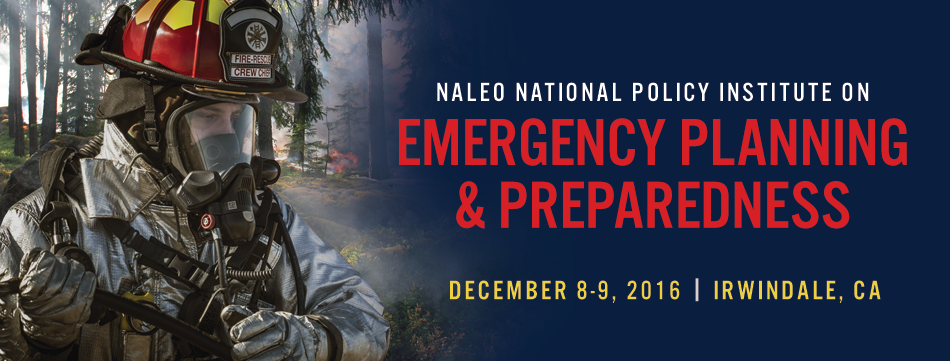
About
December 8-9, 2016 | Irwindale, CA
In the face of increasing global and domestic threats, communities across the United States are likely to experience different types of disasters and emergencies that can have devastating effects. This reality means that local and state officials must proactively consider how to prepare their communities to confront and recover from natural or man-made emergencies. While communities may not have the resources to prepare for every possible threat, they can plan for responses that make communities more resilient in the face of these events.
Effective emergency and disaster response planning entails an ongoing process of updating plans, responding to local, state, and federal policy changes, and updated understanding about hazards and implementation of best practices. Local policymakers have the opportunity to play a leadership role in these efforts by facilitating and supporting collaboration across levels of government and helping to establish key partnerships across sectors before a disaster occurs in order to advance disaster mitigation, preparedness, response and recovery.
The NALEO Educational Fund’s National Policy Institute on Emergency Planning and Preparedness will provide Latino policymakers with the opportunity to enhance their knowledge and understanding of the different levels of planning and preparedness in an effort to help their communities prepare for, protect against, mitigate, respond to, and recover from various types of disasters and emergencies.
The Institute’s curriculum will cover:
- Understanding Federal, State and Local Roles During Emergencies
- Identifying Hazards and Mitigation Planning
- Community Outreach and Risk Education
- Building Disaster Resilient Communities
- Best Practices for Improving Emergency Plans and Preparedness
The Policy Institute will convene state legislators and local policymakers with leading experts from the public, private, and non-profit sectors for two days of professional development, that combines classroom and experiential learning, and to exchange ideas and best practices. Policymakers will receive timely information, strengthen governance skills that support effective leadership, and will have the opportunity to network with colleagues and experts from throughout the country. The co-hort of policymakers that participates in this convening will be invited to participate in a second Policy Institute in 2017 that will focus on emergency management and response.
Sponsors
Title Sponsors

Schedule
- Thursday, December 8
- Friday, December 9
8:00 a.m.
Institute Registration
8:00 a.m. – 9:00 a.m.
Breakfast
9:00 a.m. – 9:15 a.m.
Welcome Remarks and Program Overview
9:15 a.m. – 10:45 a.m.
Session I:
Who is in Charge of What? Understanding Federal, State and Local Roles During Emergencies
Emergency response begins at the local level, but when local resources become overwhelmed, it is the state’s role to ensure a well-coordinated response through the combined efforts of local governments, state and federal agencies, and private sector. Understanding the scope of federal and state emergency authorities and how they interact is an important part of preparing for and responding to any type of emergency. This session will provide participants with an understanding of the critical role of federal, state, and local governments play in emergency planning and response, with a particular emphasis on the role of Governors, State Legislatures, and State Offices of Emergency Management.
• Mr. Michael Antonucci, Emergency Services Manager, San Bernardino County
PRESENTATION
• Ms. Mona Bontty, Southern Regional Administrator, Governor’s office of Emergency Services
PRESENTATION | Resource: 1
• Mr. Alex Amparo, Acting Administrator of the Field Operations Directorate and Assistant Administrator of the Recovery Directorate, Federal Emergency Management Agency
PRESENTATION
• Mr. Tom Jacobus, Edison
PRESENTATION
10:45 a.m. – 12:00 p.m.
Session II:
Identifying the Hazards and Mitigation Planning
A successful effort to plan and prepare for a disaster includes an updated knowledge of the hazards a particular community is at risk for and the impact they can have. Communities face a number of threats, therefore it is crucial to develop a sustained course of action to reduce or eliminate long-term risk to people and property. Having an updated Hazard Mitigation Plan creates a framework for risk-based decision-making by policymakers to reduce damages to people, property and the economy from future emergencies and disasters. This session will provide an overview of effective strategies for emergency planning, preparation and effective hazard mitigation planning.
• Ms. Katie Grasty, Mitigation Program, Federal Emergency Management Agency, Region IX
PRESENTATION
• Ms. Janet Ruiz, California Representative, Insurance Information Institute
PRESENTATION
12:00 p.m. – 1:00 p.m.
Networking Lunch
1:15 p.m. – 2:30 p.m.
Session III:
Building Disaster Resilient Communities
Resilience is a community’s ability to ensure and recover from diverse forms of adversity. Across the United States, many communities have experienced various types of disasters and emergencies that have had devastating effects – reminding us that natural and man-made hazards can take a high toll on communities. The high cost in loss of lives, livelihood and quality of life can be reduced by better managing disaster risks. We can strengthen resilience and improve a community’s ability to maintain and restore vital services in a more timely way and ultimately recover better and stronger. This session will highlight ways elected officials can promote community preparedness, partner with government agencies, community-based organizations, and others to help their communities respond to and recover more effectively and efficiently after disaster strikes.
• Ms. Katie Grasty, Mitigation Program, Federal Emergency Management Agency, Region IX
PRESENTATION
• Dr. Malcom Williams, Policy Researcher; Associate Research Department Director, Behavioral and Policy Sciences Department, RAND Corporation
PRESENTATION
• Mr. Jarret Barrios, CEO, American Red Cross, Los Angeles Chapter
PRESENTATION
2:30 p.m. – 5:00 p.m.
Session IV:
Best Practices for Improving Emergency Plans and Preparedness
This session will provide participants with a deeper understanding of the critical elements around prevention, preparation, mitigation, and recovery from all types of related emergencies, including active shooter and terrorism related events.
• Mr. John Diaz, Vice President of Business Operations, Emergency Preparedness Group, Inc.